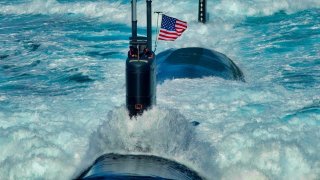The U.S. Navy 'Scrapped' A Nuclear Attack Submarine After 'Hitting' A Russian Sub
In February 1992, just months after the Cold War ended, the U.S. Navy’s USS Baton Rouge, a Los Angeles-class submarine, collided with Russia’s Sierra-class Kostroma near the Severomorsk naval base. The collision, occurring in international waters, caused damage to both submarines, though no casualties were reported.
What You Need to Know: In February 1992, just months after the Cold War ended, the U.S. Navy’s USS Baton Rouge, a Los Angeles-class submarine, collided with Russia’s Sierra-class Kostroma near the Severomorsk naval base. The collision, occurring in international waters, caused damage to both submarines, though no casualties were reported.

-The incident led to significant political fallout as Russia accused the U.S. of continuing Cold War-era spying activities.
-While the Russian submarine was repaired and returned to service, the Baton Rouge was decommissioned and scrapped, marking it as the first Los Angeles-class submarine to be retired. The event strained U.S.-Russia relations in the post-Cold War era.
1992 Submarine Collision: USS Baton Rouge vs. Russian Sierra-Class Sub
The Cold War was over, and the Soviet Union had ceased to exist just months earlier, when on February 11, 1992, the United States Navy's Los Angeles-class nuclear-powered attack submarine USS Baton Rouge collided with the Russian Navy's Sierra-class B-276 Kostroma near the Russian naval base at Severomorsk.
Even though the Cold War was over, the U.S. Navy continued to track the movement and communication of the Russian Navy, and even tapped into Russian communication cables as part of "Operation Holy Stone."
Sierra-Class vs. Los Angeles-Class Sub
USS Baton Rouge was on an intelligence-gathering mission and had reportedly been trailing the Russian sub, but each lost contact with the other prior to the collision.
The 9,000-ton Sierra-class boat struck the Baton Rouge as it was preparing to surface about 12 miles from shore.
Both subs sustained damage, but fortunately, there were no casualties.
The American boat received heavy scratches and a torn ballast tank. It could have been far worse, as the U.S. submarine had only a single hull, which if ruptured would have taken on water. The Kostroma's sail was dented on the front section.
Political Fallout
The incident was a major political disaster for the United States, as it exposed that Washington was still keeping close tabs on Russian military activity. Moreover, though the collision occurred in international waters, Moscow felt the U.S. activity had been illegally conducted.
The U.S. also tried to dispute that it was trying to shadow the Kremlin’s boat, but the Russian Navy countered that the two subs had been engaged in a game of cat-and-mouse. Further investigations by third-party analysts tended to support the Russian claims.
The collision was certainly an accident, and the USS Baton Rouge even circled to see if the Russian submarine required any assistance.
The United States Department of Defense acknowledged that a collision had occurred, which was actually contrary to official policy at the time.
The event was still significant enough that it prompted a meeting between then-U.S. Secretary of State James Baker and Russian President Boris Yeltsin to discuss the situation.
As a result of those meetings, the U.S. Navy stopped some specific submarine activities near Russia's naval bases – notably the tapping of underwater cables or the incepting of wireless communications.
End of the Line for the Baton Rouge
The Russian Navy was able to repair the Kostroma by June 1992, and she was returned to service, later receiving a major refit in 2005 – and is now in the reserve fleet.
By contrast, the Baton Rouge returned to the United States and a decision was made to scrap the boat. SSN-689 was already scheduled for refueling, and as a result, became the first Los Angeles-class submarine to be decommissioned and stricken from the Naval Vessel Register.
It is also worth noting that Russian sailors actually painted a kill marking on its conning tower to commemorate the "defeat" of the Baton Rouge. Score one for the Russians.
Author Experience and Expertise
Peter Suciu is a Michigan-based writer. He has contributed to more than four dozen magazines, newspapers, and websites with over 3,200 published pieces over a twenty-year career in journalism. He regularly writes about military hardware, firearms history, cybersecurity, politics, and international affairs. Peter is also a Contributing Writer for Forbes and Clearance Jobs. You can follow him on Twitter: @PeterSuciu.
Image Credit: Creative Commons.


